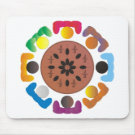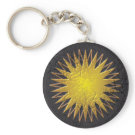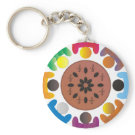ב"ה
Fractions can be daunting for children and adults, but with a few hints, they become less mysterious.
One of the things you need to keep in mind is that fractions are just numerical representations of parts of wholes. For example, if you cut a pie into two equal pieces, each piece is 1/2 (or one-half) of the pie.
Defining Fractions

Fractions are just another way of doing division. Think of them in terms of a pie or a pizza that needs to be cut into enough pieces to feed a group.
In the picture at the right, you see there are 8 people sitting around a pie. If you cut that pie so that each one gets a piece equal to all the other pieces, each person will get 1/8 (one-eighth) of the pie. This means that one pie is divided into 8 pieces.
If you had two pies to feed the eight people, each one would get 2/8 (two-eighths) of the pie (two pies divided into 8 pieces total). Another way of saying 2/8 is 1/4 (one-fourth) because each pie will need to be cut into 4 pieces (two pies cut into a total of eight pieces means each pie will need to be cut into four pieces).
Another way of looking at fractions is that you have groups of items that need to be split evenly between members of a group. The example at the right shows 12 marbles. Let's assume that three people are dividing a bag of 12 marbles. Each one gets 1/3 (one-third) of the total -- the total (one) divided by 3 people. If you count out the number of marbles in 1/3, you will see that each third is equal to 4 marbles (4/12 -- four-twelfths -- is equal to 1/3).
If there are two people, but one person gets two shares, then that person would get 2/3 or 8 marbles. The whole (1) would be the same as all three thirds (3/3).
Arithmetic with Fractions
How to add, subtract, multiply and divide fractions
In order to add fractions, you need to get the denominators (that is the bottom number of the fraction) of all the fractions to be added to be equal. Looking again at the pie example, we wouldn't know how to add 1/8 of the pie to 1/4 of the pie unless we remembered that 1/4 is the same as 2/8 (1 divided by 4 is the same as 2 divided by 8). Then you could see that 1/4 of the pie (or 2/8) added to 1/8 is the same as adding 1+2 (see below):
1/4 + 1/8 = 2/8 + 1/8 = 1+2 /8 = 3/8
This is pretty easy when you are talking about fractions that have denominators (bottom number on a fraction) that are related to each other (like 4 and 8, 3 and 9, for example), but it's harder when the numbers aren't related (like 8 and 9, for example).
Keep in mind that any number divided by itself equals one. 3/3, 8/8, 16/16, 298/298 -- all are equal to 1.
So what do you do if you have two unrelated numbers? Let's take 5 and 6. You need to find a number that both numbers can be divided into. In the case of 5 and 6, that number would be 30 (5X6). So, if you were trying to add 3/5 and 5/6, you would need to put both fractions in terms of x/30.
To do this, you need to multiply. Multiplying fractions is relatively easy. If you have two fractions, say 5/9 X 3/7 -- you multiply the numerators (top numbers) and put that as the numerator on the new fractions and multiply the denominators and use that answer as the new denominator -- in the example, you would multiply 5X3 for 15 on top and 9X7 -- or 63 -- on the bottom so:
5/9 X 3/7 = 5X3 / 9X7 = 15/63
Now back to our addition example.
If we want to add 3/5 and 5/6, we have to write both fractions in terms of how many 30ths they would be -- to do that, multiply 3/5 X 6/6, and 5/6 X 5/5. So you end up with:
3/5 + 5/6 = 18/30 + 25/30 (3X6/5X6 + 5X5/6X5) = 18+25 /30 or 43/30
Let's do another example
2/3 + 5/8 =
in order to add these two, we need to put both fractions in terms of 24ths (3X8=24), so....
2/3 + 5/8 = [2/3 X 8/8] + [5/8 X 3/3] = 16/24 + 15/24 = 16+15 /24 or 31/24
Try some of your own examples for practice on your own.
Subtracting and Dividing
Subtracting is like adding; Dividing is like multiplying
One last thought about arithmetical operations on fractions: Subtraction is like addition and division is like multiplication. How? I'll explain.
With subtraction, as with addition, you need to get the fractions into a form where the denominators are the same. For example: Let's take 5/6 and 3/5 again.
5/6 - 3/5 = (5/6 X 5/5) - (3/5 X 6/6) = 25/30 - 18/30 = 25-18 /30 = 7/30
another example:
2/3 - 5/8 = [2/3 X 8/8] - [5/8 X 3/3] = 16/24 - 15/24 = 16-15 /24 or 1/24
Division is like multiplication except you need to "flip" the term after the division sign. For example:
3/4 divided by 6/5 = 3/4 X 5/6 = 15/24 or 5/8
To understand why this works, see the picture at the right -- this represents 5 / 5/6. This means that you are taking 5 bars (or, it means you are taking 5 cups of raisins and dividing it into 5/6 cup portions). As you can see, the bars are each divided into sixths. As you can see, you can get 6 portions of five-sixths. This is the same as if you multiply 5 X 6/5 (this is the same as 5/1 X 6/5 = 30/5 = 6/1 = 6).
I hope this has helped you understand fractions a little bit better. If you have any questions, you can either leave a comment below or you can e-mail the author at compugraphdesigns@earthlink.net
If you want to test your understanding, I have Fractions Problems
here
























 The trick with word problems is to break them down to their component parts. Here is a problem:
The trick with word problems is to break them down to their component parts. Here is a problem:











 When you need to find the Lowest Common Denominator, the first thing you need to do is factor the two denominators (You'll understand why later). Let's say we have two fractions, 3/78 and 5/98. We need to add these two fractions and they don't have the same denominator.
When you need to find the Lowest Common Denominator, the first thing you need to do is factor the two denominators (You'll understand why later). Let's say we have two fractions, 3/78 and 5/98. We need to add these two fractions and they don't have the same denominator. So now that we have the two denominators factored, we have to use that factoring to figure out what the Lowest Common Denominator is.
So now that we have the two denominators factored, we have to use that factoring to figure out what the Lowest Common Denominator is. If you want to find out if a number is prime, you don't have to try to divide it by every number up to that number. (This would be really time consuming, even using [the bane of my existence] a calculator if you are trying to find out if a number such as 57,967 is prime!). First of all, 2 is the only even prime number, so other than 2, there are no even prime numbers. Second of all, any number ending in a "5" is divisible by 5 (15 is 3 X 5, 25 is 5 X 5, 35 is 7 X 5, etc.) so, other than 5 itself (which is prime) no number ending in a "5" is prime.
If you want to find out if a number is prime, you don't have to try to divide it by every number up to that number. (This would be really time consuming, even using [the bane of my existence] a calculator if you are trying to find out if a number such as 57,967 is prime!). First of all, 2 is the only even prime number, so other than 2, there are no even prime numbers. Second of all, any number ending in a "5" is divisible by 5 (15 is 3 X 5, 25 is 5 X 5, 35 is 7 X 5, etc.) so, other than 5 itself (which is prime) no number ending in a "5" is prime.

